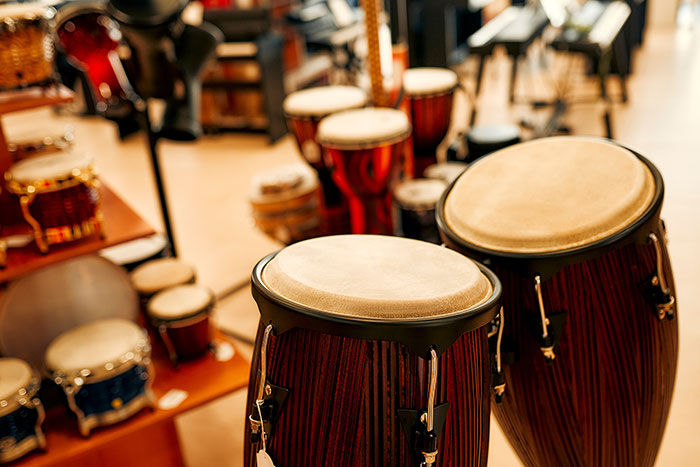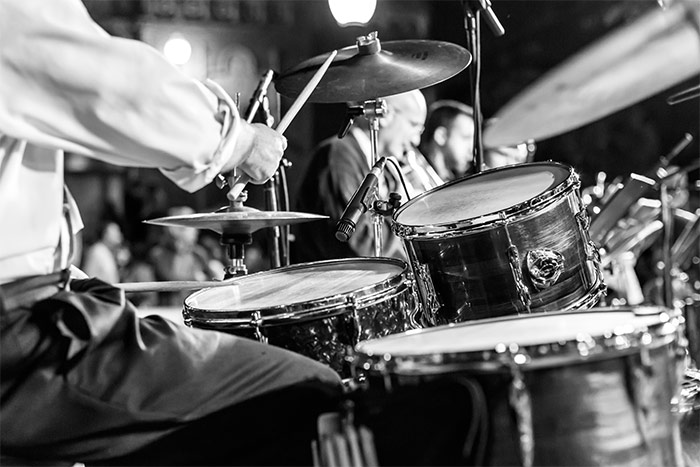Let’s take a journey through the rich history of drums, highlighting their evolution from ancient beginnings to their significance in today’s music scene.
It showcases how these instruments, with their innate ability to reverberate through the air, have remained a fundamental element of musical expression across various cultures and epochs.
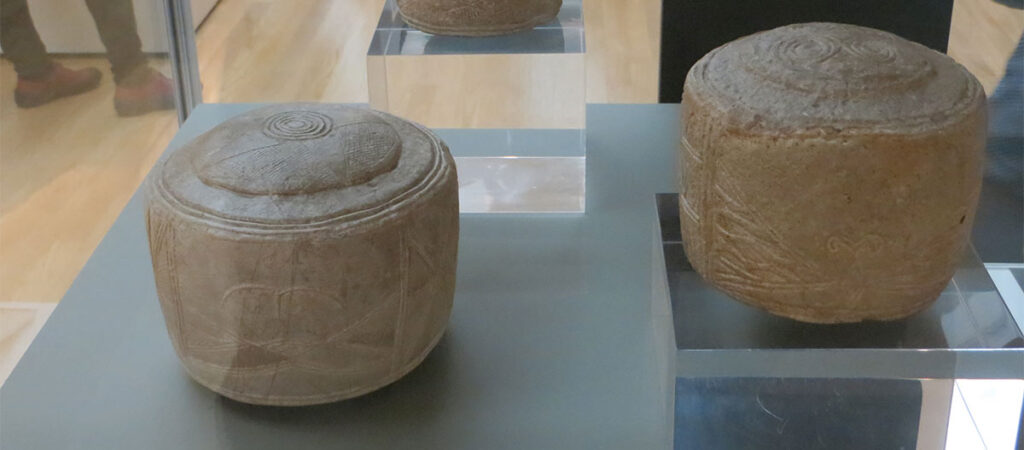
The Ancient Beginnings
The origins of drums in the ancient beginnings of human civilisation emerge as a testament to the innate human impulse for creative expression and communal connection. Delving into the depths of prehistoric times, we find that the roots of drumming lie in the discovery that striking hollowed-out logs or objects produces a resonant sound. This revelation, likely born out of experimentation and curiosity, marked a pivotal moment in the cultural evolution of early societies.
Archaeological findings offer glimpses into the earliest manifestations of drums, with significant discoveries dating back to the Neolithic period in China around 5500 BC. Among these discoveries are primitive drums crafted from hollowed-out logs and covered with alligator skins, reflecting the resourcefulness and craftsmanship of ancient artisans. Similar percussion instruments have been unearthed in various ancient cultures worldwide, from Mesopotamia and Ancient Egypt to the indigenous tribes of the Americas.
These ancient drums served multifaceted roles within their respective societies. Beyond their musical functions, they were integral to religious ceremonies, where rhythmic beats infused rituals with spiritual energy and facilitated communion with the divine. In communal gatherings, drums acted as catalysts for collective expression, fostering bonds of solidarity and belonging among tribe members.
Moreover, drums played a crucial role in communication, serving as vital tools for conveying messages and coordinating activities within and between communities. The rhythmic patterns of drums became a universal language, transcending linguistic barriers and facilitating the exchange of information across vast distances.

The Ancient Civilizations
In the illustrious epochs of ancient Greece and Rome, drums permeated various aspects of society, contributing to both cultural and military endeavours with their resonant rhythms.
In Ancient Greece, alongside the tympanum, other drum-like instruments such as the krotala and sistrum were also prevalent. The krotala, consisting of wooden clappers or castanets, added percussive texture to musical performances and religious rites. At the same time, the sistrum, a metal percussion instrument with loose rods, was often associated with worshipping goddesses like Isis. These instruments accompanied music and played crucial roles in religious ceremonies, enhancing the spiritual experience with their rhythmic vibrations.
Similarly, in Rome, drums became integral to the military apparatus, serving as instruments of rhythm and as tools of coordination and communication. Drummers, known as tubicines or buccinatores, marched alongside legionnaires, setting the pace of their advance and bolstering their resolve with martial cadences. The strategic use of drums in warfare allowed Roman commanders to convey orders amidst the chaos of battle, ensuring unity and cohesion among their troops.
Furthermore, drums’ influence extended beyond the zone of music and war, permeating everyday life in both ancient civilizations. From theatrical performances in Greek amphitheatres to public spectacles in Roman arenas, the rhythmic accompaniment of drums added depth and intensity to cultural expressions, captivating audiences and evoking a range of emotions.

The Middle Ages and Renaissance
During the Middle Ages, the evolution of drums unfolded across diverse cultural landscapes. In Europe, the tabor emerged as a prominent percussion instrument, characterised by its cylindrical shape. It gained widespread popularity, particularly when accompanied by pipes or flutes, adding rhythmic vitality to social dances and festive gatherings. The rhythmic interplay between the tabor and other instruments became emblematic of mediaeval musical traditions, infusing celebrations with joyous melodies and energetic rhythms.
Concurrently, in the Islamic world, the frame drum assumed a central role in both secular and sacred music. Renowned for its versatility and expressive potential, the frame drum featured prominently in the refined musical ensembles of royal courts, where its resonant tones enriched the cultural tapestry of the era. Whether in vibrant courtly performances or reverent religious ceremonies, the frame drum captivated listeners with its hypnotic rhythms and emotive resonance. It serves as a conduit for artistic expression and spiritual devotion.
The Renaissance era witnessed further advancements in percussion, particularly in military applications.
Building upon the foundations laid during the Middle Ages, the snare drum emerged as a transformative innovation. Distinguished by its distinctive wires or snares stretched across the drum’s bottom, the snare drum evolved from its mediaeval predecessor, the tabor.
In European armies, the snare drum became indispensable for issuing commands, coordinating manoeuvres, and instilling discipline among soldiers. Its crisp, staccato beats reverberated across battlefields, rallying troops and fortifying their resolve amidst the chaos of war, thus cementing its status as an emblem of martial prowess and organisational efficiency.
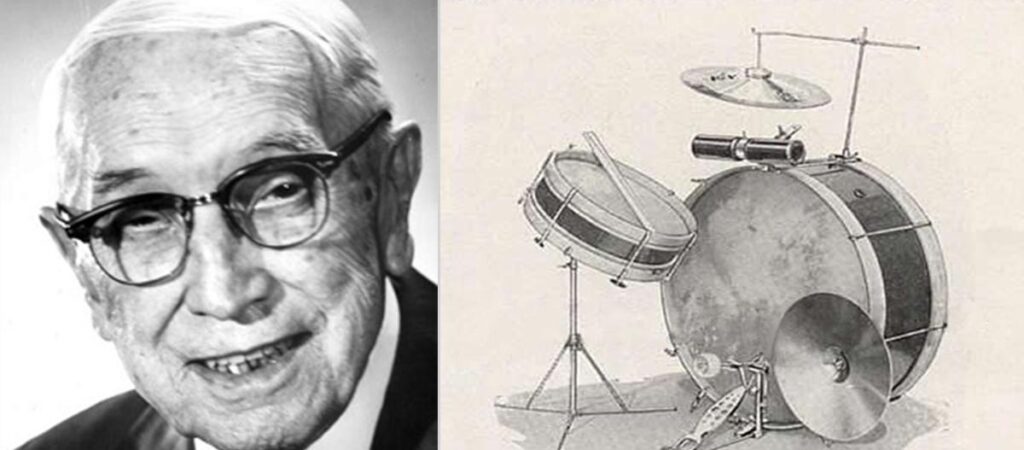
The Influence of Industrialisation on Modern Drum Kits
The Industrial Revolution significantly changed drum manufacturing by introducing new materials such as metal and synthetic skins. These materials made drums sturdier and improved their sound quality. In 1909, William F. Ludwig‘s invention of the bass drum pedal was a game-changer. It allowed a single drummer to play multiple drums simultaneously, revolutionising percussion performance. This breakthrough paved the way for the development of the modern drum kit, which quickly became popular across various music genres, including jazz, rock, and pop.
The jazz era of the 1920s and 1930s showcased the versatility of the drum kit.
Drummers like Gene Krupa and Buddy Rich pushed the boundaries of drumming, demonstrating the instrument’s potential for dynamic expression and improvisation. Their innovative techniques captivated audiences and elevated the status of drums within the jazz ensemble.
As rock and roll emerged as a dominant musical force in the mid-20th century, drummers like Ringo Starr of The Beatles and Keith Moon of The Who became household names. Their distinct drumming styles and energetic performances played a pivotal role in shaping the sound of rock music.
The drum kit became synonymous with rock and roll’s driving rhythm and infectious energy, solidifying its status as a central element of popular music culture.
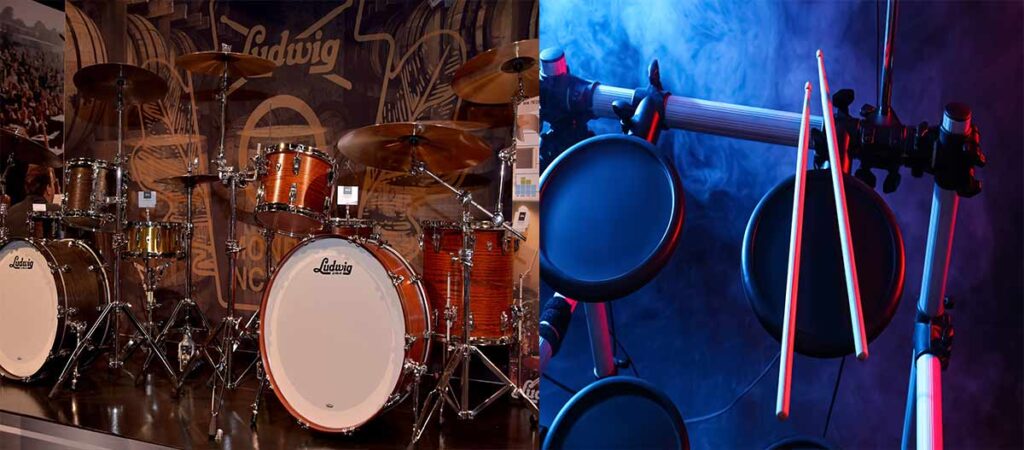
The Modern Age
In the digital modern age, from the late 20th century to today, technological advancements have greatly influenced electronic and acoustic drumming. Electronic drums, emerging in the 1970s, have evolved significantly, becoming sophisticated instruments capable of diverse sounds. They’ve found a niche in electronic and pop music, offering precise sound control and seamless integration with digital systems. This fusion of acoustic and electronic elements has transformed the creative process, allowing drummers to explore new sonic realms and expand traditional drumming boundaries.
Similarly, acoustic drums have benefited from technological innovations. Enhanced manufacturing techniques and materials have improved their durability, resonance, and tonal quality. Advances in drumhead design have also provided drummers with greater consistency and versatility in sound production. These enhancements have sustained the enduring relevance of acoustic drums in modern music.
Moreover, digital recording and production technologies have democratised music-making for both electronic and acoustic drummers. Access to digital audio workstations and virtual instrument plugins has allowed drummers to create professional-quality music from their homes. This accessibility has empowered them to experiment, collaborate globally, and share their music more widely. In summary, the digital modern age has brought innovation, versatility, and connectivity to drumming, offering drummers unprecedented opportunities for creative expression.
Summary
From ancient communication tools to a staple of orchestras, marching bands, and rock concerts, drums have had a profound impact on various aspects of cultural life.
Their evolution reflects broader changes in technology, music, and society, showcasing the drum’s enduring appeal and adaptability.
As we continue to innovate and experiment with music, the drum promises to be a central part of our musical and cultural expressions for years to come, connecting us to our ancestors and to each other through the universal language of rhythm.

